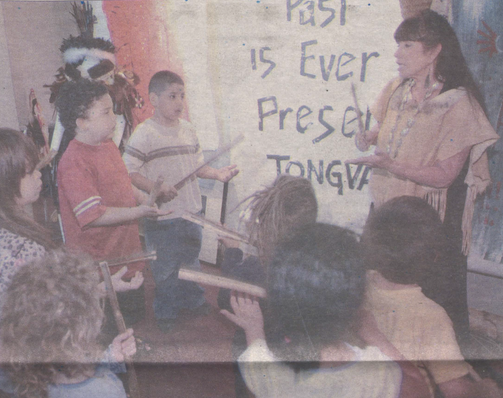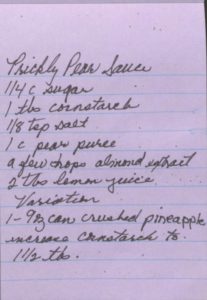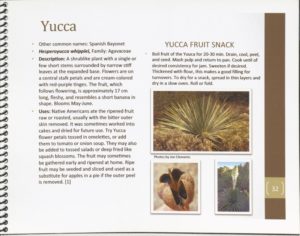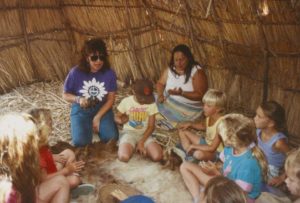
The Claremont Colleges Library is excited and honored to present a fall exhibit that highlights the newly-donated Barbara Drake Collection. This exhibit highlights the work of Barbara Drake as a Tongva Elder, educator and ethnobotanist. Visitors to the exhibit can explore Barbara’s focus on education, research, interpretive history, ethnobotany and plant medicine, plant-based recipes, language revitalization, the preservation of sacred sites, and environmental protection. This exhibit offers a glimpse into the collection which is now also available for research in-person. Highlights of this collection include:

- Photos of Barbara Drake teaching and leading programming centered around Indigenous peoples and respect for the earth.
- Plant-based recipes using native plants from California, including acorns, prickly pear and chia seeds.
- Lesson plans, educational kits and guides used by Barbara to center Indigenous history, traditions, culture and points of view.
- Native plant guides that include information about how to identify and use native plants found at The Claremont Colleges and in Southern California.
Exhibit Details
North Lobby Gallery, The Claremont Colleges Library
(800 N. Dartmouth Ave., Claremont, CA 91711)
Now – February 27, 2023
Exhibit on view during Library building hours.
Pitzer College’s English 71A Contemporary Indigenous Poetry class, led by Visiting Assistant Professor Whitney DeVos (PO ’08), curated this exhibit with the goal of learning collectively about Drake’s vital impact on surrounding communities. From Foothill Country Day School to the Claremont Colleges and the Chafee Communities Center, Drake touched learners of all levels and walks of life. She had a lasting impact on Claremont, known in Tongva as Torojoatnga or “the place below Joat,” with Joat (“snowy mountain”) referring to the sacred peak of Mt. Baldy. However, her work extended throughout Tovangaar (“the world”), the wider Los Angeles Basin. Encountering her newly-processed collection for the first time, students of The Claremont Colleges were moved by how the Barbara Drake Collection continues to impact and inform those who have the opportunity to engage with her vast and continuing educational legacy, one marked by the sharing of ancestral ways of being, learning, knowing and relating.
Exhibit Curation Approach & Process

After consulting the varied materials Drake assembled over the course of her lifelong career as a Native educator, the Pitzer students were encouraged to allow their selection process to be guided by the concept of “braiding.” In Towards Braiding, Elwood Jimmy, Vanessa Andreotti and Sharon Stein detail braiding as an encounter between goal- and progress-oriented “ways of being that emphasize individuality, fixed form and linear time” and relationality-oriented “ways of being that emphasize inter-wovenness, shape-shifting flexibility and layered time.” Without reaching toward the certainty of synthesis of these two distinct modes, braiding aims to “calibrate each sensibility towards a generative orientation and inter-weave their strands to create something new and contextually relevant, while not erasing differences, historical and systemic violences, uncertainty, conflict, paradoxes and contradictions.”
Sensitive to the ongoing harm perpetuated by museums against Native peoples as well as the complexities of preparing an exhibition from within a settler institution, the class underwent a process of collective negotiation to determine possible ways of curating Drake’s self-curated collection for public audiences. Teams selected materials that spoke to their own personal interests and political commitments, highlighting subjective experience as their chosen mode of relating to the collection. After students made their selections and authored the exhibition’s relevant contextual information, members of the Gabrielino-Tongva community were invited to provide feedback on the students’ work. The class then worked collectively to respond to the comments generously offered by Lori Reisbig, Barbara’s daughter, before mounting the exhibition.
Braiding “opens up different possibilities for engagement without guarantees about what might emerge from those engagements,” being not “an endpoint, but rather an ongoing and emergent process.” Drake’s tireless efforts to call in and construct forms of collectivity that move across identitarian lines while also complicating ways of relating to one another offer us concrete ideas of what “braiding” might look like. Hopefully this small sampling from Drake’s Collection serves to similarly illustrate and acknowledge the mutual entanglements of Indigenous and settler communities who together face an uncertain future. In this spirit, all local community members are invited to learn not only about the work of Barbara Drake and the history of local peoples, but about the violated treaties and innumerable dispossessions—historic and ongoing—and that structure contemporary life in Torojoatnga, Tovaangar and Abya Yala.
History of the Collection & More About Barbara Drake
The Drake family donated the Barbara Drake Collection to Special Collections and Archives at The Claremont Colleges Library after her passing in November 2020. The Barbara Drake Library was donated to the Robert Redford Conservancy.

Barbara was dedicated to introducing people of all ages “to seeing the natural world in different ways—as the center of all life, as cultural history, as storytelling, as tradition, as part of holistic community building,” and it was important to her to convey these ideas to children and attendees at her many teaching/speaking engagements. Born in West Los Angeles in 1940 to Tongva mother Dolores Lola Lassos and Anglo father Charles Milton Scott, Barbara Drake (née Barbara Ann Scott), was an enrolled member of The Gabrieleño/Tongva San Gabriel Band of Mission Indians and served as Tribal Secretary for many years. She also worked in Indian Education Title VII for San Bernardino Schools.
Importantly, her collection documents her role of cultural ambassador and visiting educator in Southern California Schools, museums and cultural heritage organizations where she worked tirelessly for the revival of reciprocal relations with the land and played a key role in Tongva cultural revitalization. Included in the collection are the curriculum and teaching materials Drake developed and used for her many workshops and classes, such as a Native Plants class that she taught for 25 years at Idyllwild Arts’ Summer Program, and Pitzer’s Leadership in Environmental Education Program (LEEP), where Barbara introduced hundreds of children to Tongva perspectives on the environment. She also served as a consultant on many botanical gardens, notably the Autry Museum of the American West and at Pitzer College.
Acknowledgments
This exhibition would not have been possible without the generous donation of the Barbara Drake Collection by the Drake family: Gary Drake (husband), Scott Drake (son), and Lori Reisbig (daughter). Thank you to Tongva Elder Arthur Morales and Mother Earth Clan members Cindi Alvitre and Lori Sisquoc for reviewing the collection to identify any materials of a sensitive nature or for repatriation to the Tongva community. Thank you to the Claremont Center for Engagement with Primary Sources (CCEPS) fellows, Ciara Hernandez and Daniel Talamantes, for processing the collection to make it available for research. Thank you to Lori Reisbig, daughter of Barbara Drake, for reviewing the exhibition captions and text.
Accessing the Collection
Students, faculty and staff of The Claremont Colleges, as well as members of the Gabrielino-Tongva community and the greater local community, are welcome to consult the collection for research and instruction. Read about the collection and schedule your Reading Room appointment today.
For more information, please contact Special Collections.